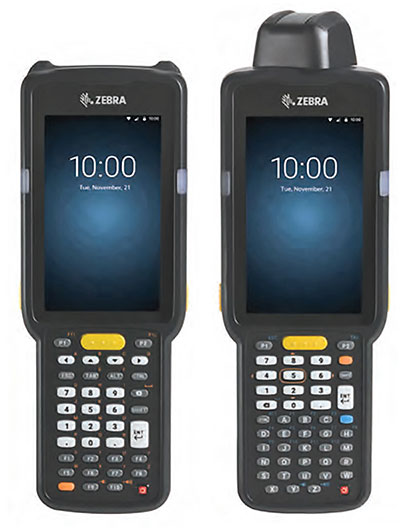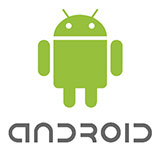|
Zebra MC3300
Vastly upgraded and improved successor to the best-selling MC3x00 Series of rugged wireless mobile handheld computers
(by Conrad H. Blickenstorfer)
The MC3300 was announced January 11, 2018 as a thoroughly modernized and updated next generation of Zebra's very popular MC3x00 line of rugged wireless handhelds that has sold well over a million units over the years.
While earlier updates to the original MC3000 platform mostly concentrated on technology upgrades and enhancements that leveraged the inherent usefulness of the device, the new MC3300 takes a bolder step forward with full commitment to the Android OS and all the technology required to make it shine. And Zebra did this while still retaining backward compatibility with many existing apps and peripherals.

What's new? A lot.
So what's new? More than the familiar look of a flashlight-style industrial handheld with a physical keypad (actually three different types) would led one to believe. That's because unlike any earlier version of the MC3x00 line, the new MC3300 is Android only.  With Microsoft's apparent withdrawal from anything but "full" Windows, there was no more need to maintain a two OS strategy (Windows Embedded Compact / Handheld / Mobile, and Android) with its unavoidable inherent compromises. With Microsoft's apparent withdrawal from anything but "full" Windows, there was no more need to maintain a two OS strategy (Windows Embedded Compact / Handheld / Mobile, and Android) with its unavoidable inherent compromises.
This meant a vast technology jump forward all the way from an older processor that was primarily chosen because it could run both Windows Embedded Compact and Android, to a much more powerful hexa-core 64-bit Qualcomm 8056, likely of the Snapdragon 650 variety. Android itself, likewise, was upgraded all the way from version 4.1 in the MC3200 to Android 7.0 "Nougat." That's a vast step in terms of Android OS functionality, ease-of-use and, most importantly to many customers, security.
Note that Zebra offers the MC3300 with the AOSP version of Android AOSP. AOSP stands for "Android Open Source Project." It is led by Google itself, but comes without the Google Play store and many of the entertainment-oriented Google apps. This makes it possible to configure MC3300's as single purpose tools via the Enterprise Home Screen utility that's part of Zebra's Mobility DNA. Zebra, however, does make GMS (Google Mobile Services) that comes with Google's popular proprietary apps available in some configurations
State-of-the-art tech
The MC3300 also has four times as much RAM and eight times as much Flash storage than was available in the MC3200. WiFi now supports the faster 802.11ac in addition to 802.11a/b/g/n. And Bluetooth is up to version 4.1.
Another big step forward is the display. While the MC3200 still had a small 3-inch screen with 320 x 320 pixel resolution (151 pixels per inch), the new MC3300 comes with a much more spacious 4-inch display with WVGA resolution that appears to be 800 x 480 pixel and thus offers a much crisper 233 pixels per inch. That's sharper than a "retina" iMac. And with Windows Embedded Compact gone, there was no more need to hold on to a resistive digitizer and so the MC3300 has capacitive touch.
On the data capture side, the Zebra SE965 1D laser and 2D Zebra SE4750 imager did not need replacement. And the SE4850 Extended Range Imager is now available as well. Specs also refer to a 13mp camera, great to document incoming shipments, condition, etc.
Fine-tuned ergonomics
The form factor has changed a little to accommodate the bigger screen. The standard MC3300 is about half an inch longer than the MC3200. It's quite a bit thinner though (1.35 vs 1.8 inches) and thus weighs roughly the same as the older model. This means that many older MC3x00 Series peripherals and accessories still work with the MC3300, a big plus for existing customers.
As before, customers can select from three different keypads (29-key numeric, 38-key function-numeric, and 47-key alpha-numeric). And there are now four different physical configurations (standard "straight shooter" imager or laser, rotating gun turret laser, pistol grip imager or laser, and — new — a "45 degree" imager scan versions. MC3300 customers will greatly appreciate having all these versions available; if you scan thousands of items a day and enter lots of data, having just the right scanner at just the rate angle and just the right keypad means a lot.
On the power side, the standard battery packs 10 watt-hours, an available high-capacity battery 19.2 watt-hours, the latter standard with the pistol grip version.
Tougher than ever
The MC3300 is even more rugged than the MC3200 was. It is now able to survive multiple 5-foot drops and 1,000 tumbles from a meter (3.3 feet). It can operate within an extremely wide temperature range of -4 to 122 degrees Fahrenheit and carries an IP54 ingress protection rating, which means it is protected against dust and also against water spray from all directions.
The accelerometer, what the company calls "Enterprise-class Interactive Sensor Technology," enables all sorts of motion-based applications, including dynamic screen orientation (useful when dealing with customers), things like automatic logging of drops, or even power savings (device turns off when no motion is sensed for a period of time).
A classic now ready for the future
Overall, the MC3300 represents a major update and enhancement to the company's very popular MC3x00 platform. It brings a clear commitment to Android and modern technology to a keypad-equipped industrial handheld form factor that still works best for many customers.
And even more than its predecessors, the new MC3300 excels in ergonomics with its variety of available keypads, and in substantial backroom functionality that includes not only Zebra's massive software support, but also a wealth of modular mounting, charging and expansion accessories. — Conrad H. Blickenstorfer, January 2018
|



